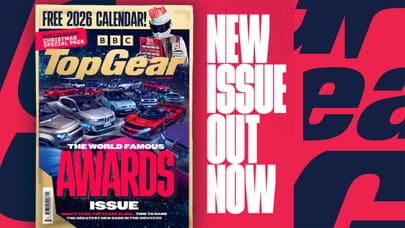
Top Gear's greatest cars of the last 30 years: BMW i8 and Porsche Taycan
In our increasingly electrified world, two pioneers have stood taller than others
We were surprised as well. Only one Porsche has ever been crowned TG’s Car of the Year, and it’s the one without a combustion engine. Meanwhile, no BMW M car has ever taken the top prize. The only Beemers to walk away with the laurels are an executive saloon still held in high regard today, and a petrol-electric sports car that bravely looked to a future that hasn’t materialised. Raises the question really: which of this pair is a surefire future classic?
We know a winner when we see one. BMW’s £900m investment in its i range is now a cautionary tale of how to go too far, too fast with cars of the future, with the i3 and i8 now relegated to history and the current range taking the far more conventional shape of stuff like the iX1, i4 and i7. The only ‘bespoke’ EV BMW makes these days is the iX. A fine luxury pod dressed up like a robo-hippo, but a far cry from the days when bespoke aluminium chassis bore recycled carbon-fibre superstructures.
When aerodynamics, not marketing, styled the cars. When BMW would sell you a butterfly door streamliner powered by a 3cyl Mini engine tuned to deliver over 230bhp, boosted by an electric motor for 0–62mph in 4.4secs, plus claimed economy of 134mpg. Not the i8’s fault the test cycle was laughably flawed.
The i8 was a monumentally daring project. And if you compare its sales with the contemporary Porsche 911 Carrera’s, or its residual values, you’re forced to conclude it was a failure. Commercially, yes. But here and now it looks like a door to a happier alternate reality, slammed shut in favour of the easy road.
The Taycan is actually a less courageous concept. Tesla had completed a fastback-topped skateboard-of-batteries seven years sooner, but Porsche was the first – and is still among the only carmakers – to take two and a bit tonnes of lithium, copper and leather and morph it into a car you might enjoy driving. A car worth pulling out of an HGV’s slipstream for, because it steers and stops and corners with something approaching panache.
And it has been a success, albeit one that’ll have to go some to recoup the eye-watering £5bn investment Porsche funnelled into its Zuffenhausen workshop. Taycan sales quickly outstripped the rate Porsche shifts its touchstone 911. Aided by GTS this and Turbo that, it vies with the Macan for the honour of UK’s best-selling Porsche. Svelte saloon, wagon or an Audi Allroad-ish crossover. Rear or AWD. The polished dynamics expose the infancy of Tesla’s immaturity in setting up cars, but the 250-mile real world range is comprehensively humiliated by the Californian upstart.
Porsche’s first EV then, like BMW’s singular plug-in hybrid sports car, isn’t a slam dunk template for the future of the driver’s car. Both are flawed. Both have wrinkled tech specs as the pace of improvement leaves their early adopter attempts in the dust. How quaint the i8’s 18-mile e-range seems now a hybrid Range Rover can manage over 60.
Perhaps then, neither won because they were the most perfectly executed pieces of engineering from their respective years. The i8 and the Taycan were each winners because in an uncertain time of upheaval for the motorcar, they gave us hope.
Top Gear
Newsletter
Thank you for subscribing to our newsletter. Look out for your regular round-up of news, reviews and offers in your inbox.
Get all the latest news, reviews and exclusives, direct to your inbox.
Trending this week
- Car Review
Porsche 911 GT3 (992.2)








